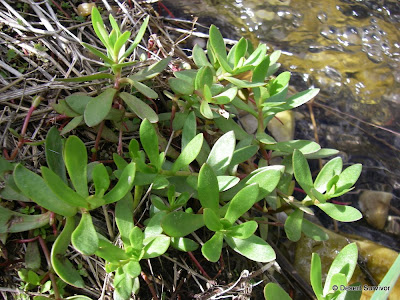
This high elevation columbine is so beautiful I had to take a lot of photos of it! It's Utah columbine (
Aquilegia scopulorum), part of the Buttercup Family (Ranunculaceae). As you might guess, it grows in Utah, along with Nevada, Colorado, and Wyoming.

It has long spurs that protrude behind the flower, and the leaves have a bluish tinge and are in tight mats.

Bees and butterflies pollinate these columbine, and you can find an interesting natural history about how
Aquilegia crossed the Bering land bridge 10,000 to 40,000 years ago
here.


For more info about Utah columbine, click
here.
 The genus Draba, part of the Mustard Family (Brassicaceae) is one tough genus to puzzle out. Fortunately for this one I had the help of a botanist. It's Cusick's draba (Draba pedicellata ssp. wheerensis), only found on the Snake Range in Nevada. There are no leaves above the basal cluster. Another identifying mark are the yellow flowers, but all the specimens we saw were past flowering.
The genus Draba, part of the Mustard Family (Brassicaceae) is one tough genus to puzzle out. Fortunately for this one I had the help of a botanist. It's Cusick's draba (Draba pedicellata ssp. wheerensis), only found on the Snake Range in Nevada. There are no leaves above the basal cluster. Another identifying mark are the yellow flowers, but all the specimens we saw were past flowering. It's a tiny plant that likes growing in crevices.
It's a tiny plant that likes growing in crevices. For more information about Cusick's draba, click here or here.
For more information about Cusick's draba, click here or here.

















































